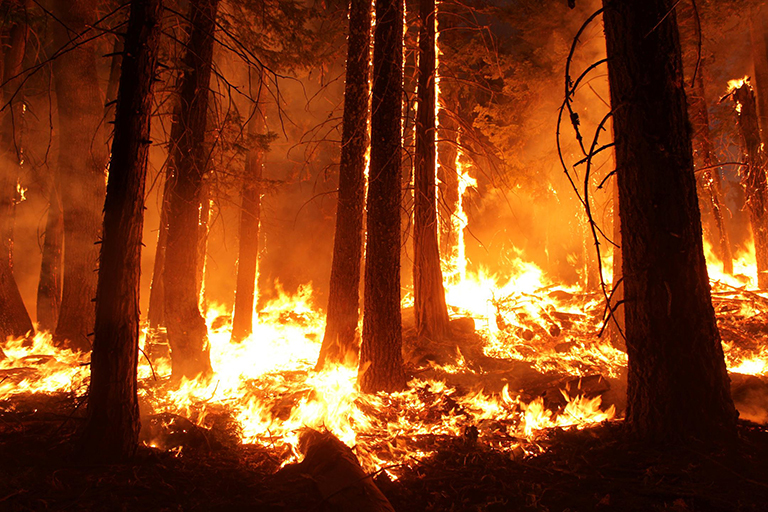Adam Osborne (Year 12)
It is without doubt that we are currently experiencing a climate crisis in the form of climate change but what exactly is climate change and what are the ways in which we can slow down the impacts it is causing on Earth. In this essay I will go into what climate change is, the effects of it and certain mitigation measures and adaptation strategies we can undertake to save our planet for our future generations from suffering irreversible damage.
Climate change refers to the long-term shifts in the weather patterns and global temperatures. This has been caused both naturally and from humans. The main human activities that have driven climate change include the burning of fossil fuels and deforestation. The burning of fossil fuels results in large amounts of carbon dioxide being released which is a greenhouse gas. Greenhouse gases trap heat in our atmosphere which causes global warming which means that temperatures begin to rise. Furthermore, deforestation is another act which contributes heavily to climate change as trees act like carbon sinks as on average a typical tree can absorb around 21 kilograms of carbon dioxide (CO2) per year. Trees are cut down for various reasons (mining or for construction of buildings to begin). The act of deforestation releases carbon dioxide into the atmosphere and, as talked about previously, causes global warming leading to rising global temperatures. Additionally, trees may be destroyed using the slash and burn technique where trees are burnt down instead of cut down. This causes more carbon dioxide to be released in the atmosphere exacerbating the knock-on effects onto the environment as temperatures will begin to rise at a quicker rate. Having demonstrated what climate change is and how humans are the main culprits for this taking place I will now move onto the risks that come as a result of climate change.
The United Nations lists a multitude of effects for climate change highlighting the devastation climate change can cause socially, economically and environmentally. One risk associated with climate change is the increasing severity of storms. Around the world in various regions extreme weather events such as storms have been more frequent, severe and destructive. This is because as temperatures rise, more moisture evaporates, This intensifies extreme rainfall and flooding, making storms more destructive. This can have devastating knock--on effects both socially and economically as if storms become more destructive and frequent they can pose a greater danger to life and will cause more injuries. Additionally diseases could spread in the aftermath and people could lose their homes and their jobs as business buildings may be destroyed. Transport networks could also be heavily disrupted due to flooding making some modes of transport inaccessible. This one impact and several secondary impacts demonstrate the dangers and devastation that climate change can pose to the environment and to the whole world both socially, as it affects people’s quality of life and economically, as many businesses may shut down and people may lose their jobs and source of income in the wake of a storm. The deadliest and costliest tropical cyclone of the year is Cyclone Daniel, which killed at least 4,034 people in Libya, Greece, Turkey, and Bulgaria. It also caused at least US$21.14 billion worth of damage (mostly in Libya and Greece). This shows how storms are intensifying and climate change is causing immeasurable damage in the present day.
Another risk associated with climate change is rising sea levels. According to climate.gov the rate of sea level rise is accelerating. This is worrying as it can trigger a positive feedback response as rising temperatures cause more ice to melt. If more ice melts there will be less ice caps to reflect sunlight back into the atmosphere causing ocean temperatures to rise and as more carbon dioxide is absorbed into the ocean. This also makes the ocean more acidic posing a threat to marine ecosystems and coral reefs. This highlights how climate change is having a large impact on ecosystems and biodiversity and will continue to do so if action is not taken.
Despite having outlined the several severe risks that are associated with climate change there are various ways to mitigate the effects of climate change. This includes using renewable stores of energy (for example: solar panels, wind turbines) rather than fossil fuels, reducing our carbon footprint by using more public transport and reducing journeys by car. By using electric cars we can also reduce the amount of greenhouse gases that we emit. When it comes to global changes in Brazil, there has been a reduction in deforestation by 34% in the first half of 2023 indicating how vast amounts of forest is being protected in Brazil, home to the majority of the Amazon Rainforest. In addition international agreements have taken place in recent history. An example of this is the Paris agreement in 2015 where commitments were made from countries to reduce their carbon emissions. However this agreement didn’t have the power to force a country to cut their carbon emissions so there were no consequences High income countries (HICs) do not experience the brunt of the impact when it comes to the climate crisis so will be less inclined to reduce their carbon emissions whilst low income countries (LICs) are more likely to suffer heavily from events such as tropical storms as they do not have the income to prepare and protect themselves from extreme weather. This signifies how whilst steps are being made to combat climate change there are still big steps to be made and they must be taken quickly in order to limit the incoming devastation to the environment.

Comments
Post a Comment